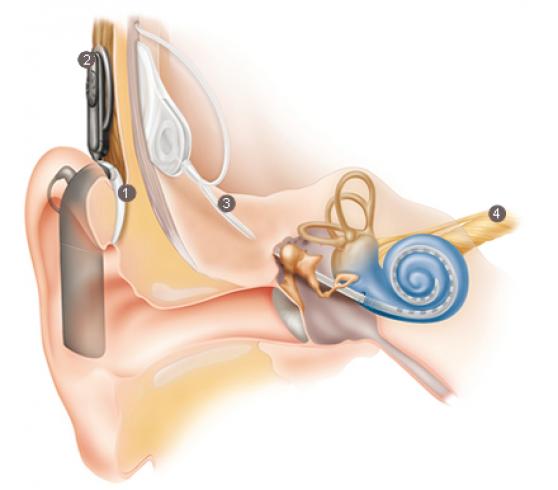 Kuva: Cochlear.com (Cochlear Ltd.)
Kuva: Cochlear.com (Cochlear Ltd.) Cochlear implant surgeries are carried out in all university hospitals (HUS, TYKS, TAYS, KYS, OYS). The child is anesthetised for the duration of the surgery and preparatory instructions for the surgery are provided from the hospital. The surgery takes 3–5 hours, depending on the age of the child, the structure of the ear and on whether one or two implants are implanted for the child. Time seems to stop for a waiting parent, so it is worth taking something to do with you or go for a walk. After surgery the child is taken to the recovery room and then brought to the ward when he/she has woken up.
In general, the child spends the night following the surgery in hospital, sometimes longer if recovery requires it. Generally, a parent can stay at the hospital with the child. It’s worth remembering to take the child’s soft toy or other important toy, reading and things to do.
Surgery progress
Cochlear implant surgery is equivalent to an ordinary ear surgery. During the surgery, an incision is made behind the ear. The cochlear implant is attached to the bone behind the ear. A small cavity is drilled through the mastoid cortex behind the ear, so that it extends to the middle ear. If necessary, a very small hole is made in the wall of the middle ear. Through this, an electrode is directed to the cochlea. The so-called round window already in the bone structure may be used to take the electrode wires through. The electrode is attached in such a way that the wire is flexible as the child grows. The internal part has a magnet, which allows an external antenna to be held in place on the skin surface.
After the surgery
The physician will check the surgical wound before discharging and usually the bandaging is loosened at this point. Upon leaving to go home, the family will be given instructions for rest, wound care and follow-up measures. During the first few days, swimming, sauna and heavy lifting should be avoided. The stitches can be such that they melt away by themselves or they will be removed approximately two weeks later. The activation of the implant’s external part, i.e. the processor, takes place about a month after the surgery, when the wound has healed.
Surgery risks
The surgery involves risks which parents need to know. If the risks are of concern, or raise additional issues, they should be discussed with the attending party.
At the time of the surgery, the child must not have a middle ear infection (otitis media), or any other inflammation. If this is the case, the surgery must be postponed because the anesthesia involves risks in this case.
The cochlear implant is a foreign object, even though it is very well tolerated. There is a very low risk of rejection and infection.
During the surgery, an opening is drilled behind the ear, through which the electrode is taken to the inner ear. The drilled opening passes close to the facial nerves and taste nerves. Temporary facial nerve numbness or taste disturbances are possible. With current surgical techniques permanent facial palsy is, however, highly unlikely.
After the surgery, the patient may have some pain, which can be generally controlled with drugs. Children often recover from surgery quickly.
The cochlear implant surgery is associated with a very low risk of meningitis. In Finland, the risk is reduced with pneumococcal and hemophilius vaccinations prior to the surgery.
Any potential residual sense of hearing may be lost during the surgery, i.e. the ear may become deaf in the traditional sense. Current surgical techniques, however, save the residual sense of hearing better all the time. Generally, hearing gained with the cochlear implant is clearly better than the level provided by a traditional hearing aid.




